Latest Blogs
Software Development
Ramsha Khan
Nov 26, 2025
Enterprise Application Development: A Complete Guide for Modern Enterprises for 2026
Read More...

Blockchain’s Role in Insurtech Data Integrity
Insurance lives and dies on trust. Policyholders trust carriers to keep accurate records, pay legitimate claims, and protect sensitive data. Insurers trust each other, brokers, and regulators to be honest and auditable. Insurtech, technology that modernizes insurance, has already changed how companies price risk, process claims, and serve customers. But one of the most powerful tools in the insurtech toolbox for strengthening data integrity is blockchain.
Below, we’ll walk you through, in plain language, how blockchain adds real value for insurers: from immutable records and smart contracts to fraud prevention, claims automation, and meeting regulatory compliance needs. We’ll use simple examples, touch on practical limits, and close with answers to the most common questions.
At its simplest, data integrity means data you can trust: complete, accurate, tamper-evident, and auditable. For insurance, that means:
Traditional systems store this data in centralized databases. That works, but it creates single points of failure, reconciliation headaches when multiple parties are involved, and opportunities for fraud or accidental changes.
A blockchain (or distributed ledger) is a shared database where transactions are recorded in an append-only chain of blocks. Two important features for insurance are:
When insurers, reinsurers, brokers, hospitals, and regulators agree to share certain data on a permissioned ledger, everyone gets the same view of truth. That’s hugely helpful for transparency, digital trust, and risk management.
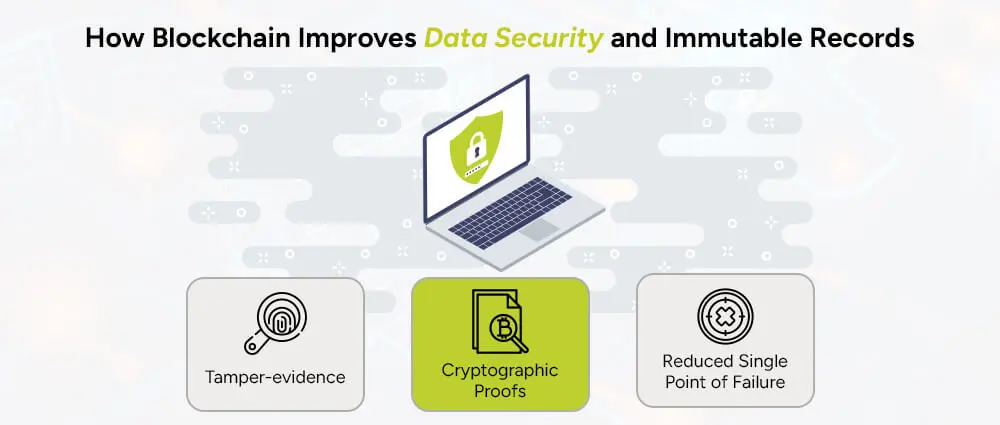
Blockchain helps data security in three practical ways:
Edits to records are visible because each new block references the previous one. If someone tampers with old data, the chain won’t validate across the network.
Entries are cryptographically signed, so you can cryptographically verify who added what and when.
With permissioned blockchains, multiple trusted parties host nodes, reducing the risk that one compromised system ruins the whole dataset.
Put together, these features create immutable records that auditors and regulators can rely on. That’s not the same as making everything public; permissioned ledgers can still restrict who sees what while preserving integrity.
One thing to remember: blockchain strengthens integrity but does not replace the need for good access controls, encryption of sensitive fields, and secure key management.
One of the most practical Insurtech applications is combining blockchain with smart contracts, small programs that run on the ledger and execute when preset conditions are met.
Imagine a travel delay policy: if flight delay data (from a trusted oracle) shows a qualifying delay, a smart contract automatically triggers a claim payment to the policyholder. That’s claims automation with fewer manual steps, fewer disputes, and faster payouts.
Smart contracts must be carefully written and tested; bugs here can cause wrong payouts or stuck claims, so governance and fallback processes are critical.
Fraud is responsible for costing insurers billions every year. Blockchain will discourage such fraudulent acts by making it easy to spot duplicate claims, staged events, or inconsistent histories:
Regulators want clear, auditable trails. Blockchain naturally supports auditability by recording who did what and when. Permissioned ledgers make it possible to:
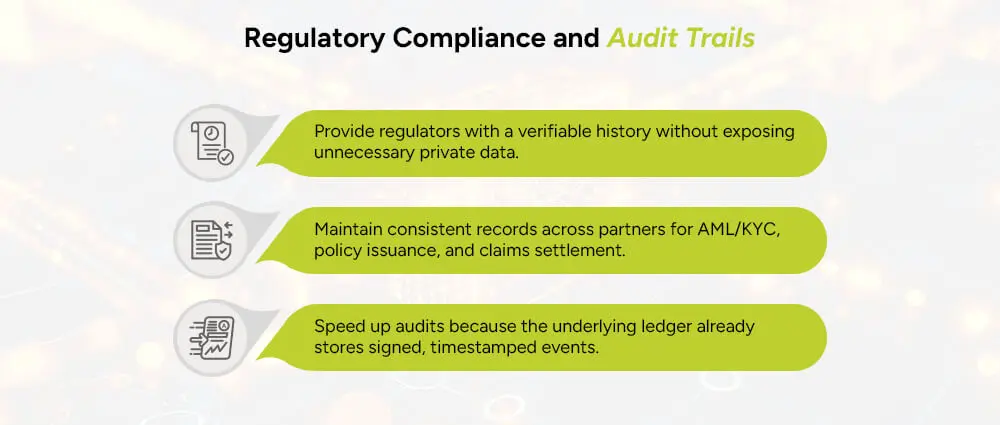
This doesn’t remove the need for legal and compliance teams, but it streamlines audits and improves regulatory compliance readiness.
Some real-world use cases that benefit most:
Industry research also shows growing interest: market forecasts project strong growth in blockchain use within insurance, as companies invest in verification, reconciliation, and automation tools. For example, one market analysis projects the blockchain-in-insurance market to expand significantly over the coming years. Many insurance firms report plans to increase blockchain investment as they target claims automation and fraud prevention.
Blockchain isn’t a silver bullet. Here are practical limits to consider:
Good implementations mix blockchain with proven engineering practices: off-chain storage for heavy or private data, signed hashes on-chain for integrity, and clear legal agreements among participants.
Technology alone doesn’t create trust; people do. Blockchain is a tool that makes it easier to prove things to customers, partners, and regulators. Pair it with transparent governance, strong security practices, and user-friendly interfaces, and insurers can deliver real digital trust to customers.
To successfully implement blockchain, insurers should identify various applications but zero in on a high-value, focused use case for entering the blockchain space, such as claims handling. Sensitivity regarding information requires using permission ledgers, which enable storing on-chain only cryptographic proofs. Key elements needed for success include strong governance, reliable identity framework, trusted data oracle, but above all, a pilot with key partners like brokers, reinsurers, or hospitals to get the real value out of network collaboration.
At Arpatech, we help businesses navigate this journey by designing blockchain solutions tailored for insurance, ensuring data integrity, regulatory compliance, and seamless integration with existing systems, so you can build trust, reduce risk, and innovate with confidence.
It stores signed, timestamped entries in purely append-only ledgers, rendering records tamper-evident and readily verifiable by various parties. In combination with on-chain hashes and off-chain secure storage for private data, one can obtain both privacy and integrity: the ledger proves, without revealing any sensitive content, that data did exist at a certain state.
Yes, they really do. The audit trails created by blockchains show who has entered data and the time. Permissioned ledgers allow insurers to build access for regulatory purposes to verifiable data without publishing customer details publicly. That gives rise to faster audits and lesser work during reconciliation. It should be noted that it must be supplemented with proper governance and privacy practices to be able to satisfy legal requirements.
Top beneficiaries include:
Ramsha Khan
Sep 30, 2025

AI-Driven Automation for Seamless Insurance Operations
Insurance firms have always been about balancing risk, speed, and trust. Lately, there’s a new teammate on the floor: artificial intelligence. When layered into existing systems as AI in insurance operations, it becomes a force multiplier, streamlining manual work, improving customer service, and helping underwriters and claims teams make sharper decisions.
Today, I’ll walk you through practical ways AI is used right now, why it pays off, and how teams can start without getting lost in the buzzwords.
Think about the repetitive, rule-based tasks that gobble up hours every day: opening claims, verifying documents, filling forms, routing policies for signature. That’s exactly the kind of work intelligent automation handles best. By automating routine flows, insurers free people for judgment-heavy tasks, the ones where nuance, empathy, and experience still beat a model.
Two sources that tell the story:
In a 2024 McKinsey survey, about 65% of respondents said their organizations were regularly using generative AI, a sign that insurers aren’t just experimenting; they’re deploying AI in production.
A recent NAIC survey found that 84% of health insurers report using AI/ML in some capacity, showing broad, real-world uptake in a highly regulated line of business. Those numbers mean what you think: AI isn’t hypothetical. It’s driving process optimization and cost reduction now.
Claims are a prime target. The typical lifecycle, intake, validation, estimate, and settlement, has many hand-offs and document-heavy steps. AI can:
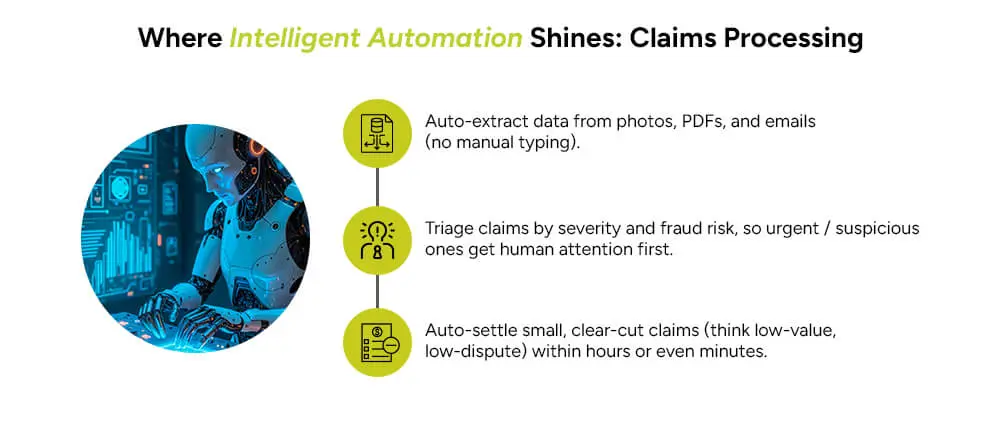
That combination speeds up turnaround and reduces back-office toil. Insurers using automated claims flows often report big improvements in cycle time and customer satisfaction because people get paid faster and with fewer hoops to jump through.
Industry analyses have found that automated claims processing can reduce the time to settle by substantial margins.
Underwriting used to mean shuffling paper, hunting for prior-loss history, and slow manual scoring. Now AI and predictive analytics change the game:
That’s underwriting automation: faster quotes, more consistent risk selection, and, most importantly, better alignment between premium and risk.
Policy admin (endorsements, renewals, cancellations) is ready for robotic process automation plus AI:
All of this reduces processing time and human error, and supports cost reduction without sacrificing service levels.
Predictive analytics isn’t only for pricing. It helps insurers forecast where losses will concentrate (e.g., flood-prone zones, rising claims in a particular product), decide where to invest in loss control, and design prevention programs for large groups of policyholders. Combine that with real-time data (IoT sensors, telematics) and you move from reactive claims-paying to proactive risk management.
A common fear is that automation will erase human roles. Reality: the highest-value outcomes come when AI does the heavy lifting and humans apply judgment. For example:
This is where you get the most durable ROI: people doing what only people can do, machines handling the rest.
Insurers operate in regulated environments. That means any AI system must be auditable, explainable, and fair:
This is not just compliance theater; it improves models and builds trust with regulators and customers.
AI reduces cost in multiple ways: fewer manual hours, fewer mistakes, faster settlements (which reduces legal and administrative drag), and better risk selection. But the fastest, most reliable ROI usually comes from operational efficiency projects, automating repetitive workflows and claims triage, rather than attempting to replace core actuarial judgment overnight.
BCG and other consultancies have noted that customer service and automation often account for a large share of early AI-generated value in insurers.
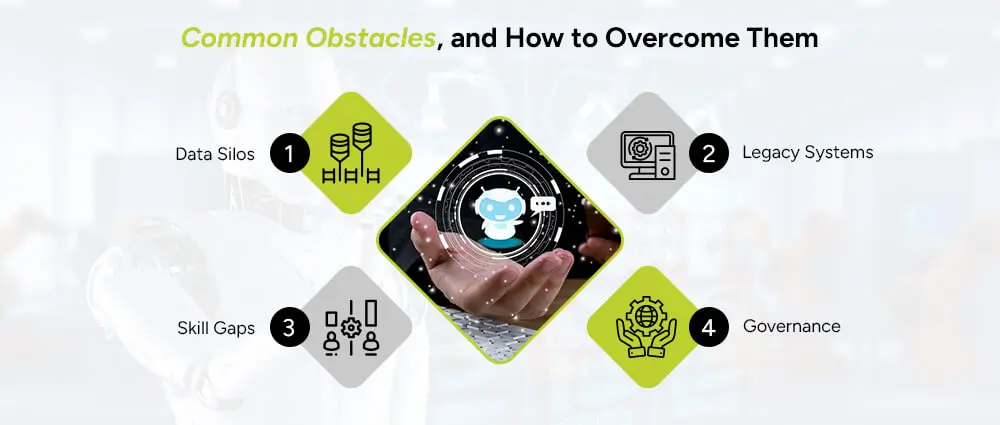
AI adoption in insurance isn’t without hurdles. But most challenges have practical solutions that help insurers move forward with confidence.
Claims, underwriting, and customer data often sit in separate systems, limiting AI’s effectiveness. Centralized data stores or APIs can break down these walls and improve accuracy.
Old platforms can’t be replaced overnight. Integration layers and gradual migrations let insurers connect AI to existing systems without major disruption.
Underwriters and adjusters may lack AI know-how. Upskilling teams with basic AI literacy and adding a small data/ML ops group bridges the gap.
AI must stay transparent and compliant. Early frameworks for logging, bias checks, and human oversight keep operations safe and trustworthy.
These challenges may seem daunting, but with smart planning, they become stepping stones. By tackling silos, legacy tech, skill gaps, and governance, insurers can unlock the real benefits of AI in insurance operations, smoother workflows, lower costs, and stronger customer service.
Cycle time drop, if time-to-claim resolution or quote-to-bind falls significantly, automation is working. Many insurers report substantial reductions once automation is in place.
Worker redeployment, if back-office staff shift from data entry to exception-handling, you’ve moved from cost-cutting to capability-building.
AI-driven automation is a practical lever for insurers who want faster operations, lower costs, and better customer experiences. Start small, govern carefully, and design for collaboration between machines and people; that’s the formula for seamless insurance operations.
At Arpatech, we help insurance providers put these ideas into action by building personalized AI development solutions, streamlining claims and underwriting workflows, and ensuring compliance is never compromised. If you’re ready to transform your operations with intelligent automation, our team can guide you every step of the way.
Immediate returns tend to occur in areas that provide sittings on high-volume and low-complexity operations: claims intake and triage, document extraction, policy administration, and simple underwriting decisions. The beauty of AI here is that it quickly eliminates manual hours, reduces cycle times, and lowers error rates-an excellent demonstration for measurable returns.
The essence of the AI within insurance companies is governed clearly: controlled versions of models are used with logs of decisions made, with tools for explainability, tests for bias, data privacy fully enforced, and human-first oversight of any significant decisions. Achieving regulatory engagement and documenting what goes into and comes out of a model enhances applicable standards and guidelines for AI use.
Not now, at least for the near-term. AI takes care of the repetitive parts of the job but actually supports real-time decision-making. The human expert is still extremely important, where the judgment call is complex, where relationship management enters, or where exceptions need to be handled. In all likelihood, we will see an evolution of the roles: colleague decision-making or strategic work to humans, while computers will carry out rule-based execution.
Start with the cleanest data that will give you the largest impact: claims history, policy metadata, customer contacts, and most-used forms/documents. For underwriting in particular, exposure data and loss history are key. Even if the data is not perfectly clean, run a pilot under minimal requirements to narrow down the use case and iterate toward better data quality.
Ramsha Khan
Sep 25, 2025
Enhancing Real-Time Logistics Visibility with Advanced ...
If you’ve ever watched a map pin crawl across your screen and thought, “Why can’t all my shipments be this clear?”, you’re already craving Real-Time Logistics Visibility. Customers want live updates. Operations teams want fewer surprises. Finance wants predictable costs. The good news? With today’s shipment tracking, sensor technology, GPS tracking, and smarter platforms, real-time visibility is finally practical, not just for global giants, but for growing shippers and 3PLs too.
Below, we’ll break down what real-time visibility actually means, how it works, where IoT in logistics fits in, how predictive ETA helps you make better promises, and how to roll it out without blowing up your budget or your processes.
Think of visibility as one live timeline for every order and freight monitoring event, across carriers, modes, and partners, updated continuously by devices and data feeds. Real-time visibility usually includes:
With all that in one place, you get supply chain transparency that’s actually usable, not a stack of spreadsheets that’s out of date by the time you hit refresh.
Legacy tracking depends on sporadic barcode scans. That’s better than nothing, but it leaves huge blind spots between handoffs. Real-time systems, by contrast, stream data continuously. Small, low-cost devices and vehicle telematics feed your visibility platform minute by minute. That means you see what’s happening, not just what happened.
A powerful proof point: analysts reported that last-mile delivery can account for about 41% of total logistics costs, which is exactly where delays, missed windows, and “where’s my order?” calls stack up. Real-time visibility helps teams compress that cost by preventing waste, rerouting in the moment, avoiding failed deliveries, and coordinating handoffs.
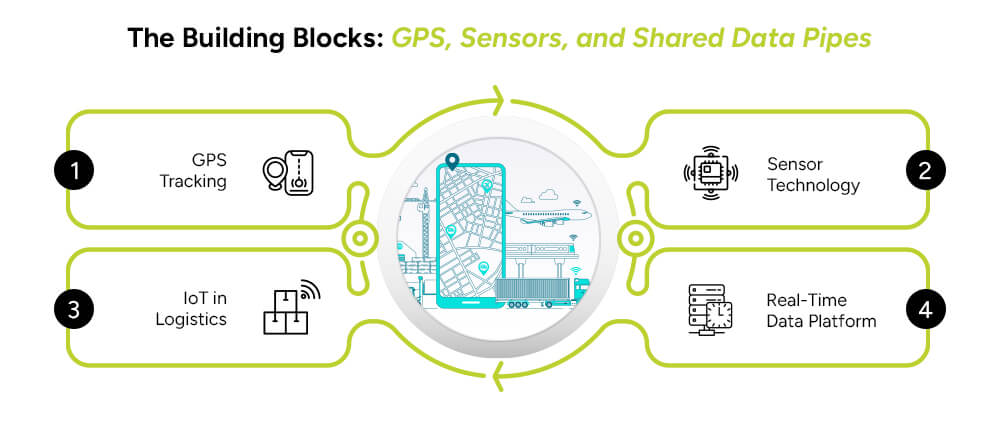
Modern visibility stacks feel complex, but they boil down to a few building blocks:
The explosion of connected devices is what makes real-time affordable and scalable. Research indicates the number of connected IoT devices reached 16.6 billion in 2023 and is expected to grow to 41.1 billion in 2030, a wave that’s directly powering logistics visibility use cases (from trailer tracking to pallet-level monitoring).
Classic ETAs assume everything goes right. Predictive ETAs use real-time data: traffic, weather, port congestion, dwell history, driver hours, and lane performance. The result is a moving ETA that gets smarter with each update, so planners, warehouses, and customers can adjust before a delay becomes a crisis.
This shift matters. Ocean, air, and road networks are volatile. Predictive ETA narrows uncertainty, improves on-time performance, and reduces costly “hot” shipments. In practice, teams use predictive ETAs to:
Real-time visibility drives operational efficiency because you’re not fighting blindfolded. Common, measurable wins include:
Even small percentage gains compound across lanes, seasons, and partners, especially when last mile is such a large cost bucket.
Great visibility isn’t a dashboard you admire, it’s a shared view people act on. Best practices:
Freight monitoring extends beyond dots on a map to the physical state of goods. For temperature-controlled shipments, add:
This is visibility that prevents loss, not just reports it after the fact.
Customers don’t judge you by upstream brilliance; they judge you by the doorbell ring. Strong last-mile tracking combines:
Because last mile drives the largest cost share, it’s also where visibility delivers the fastest ROI.
You don’t have to do everything at once. Start small and grow step by step. This is how to can go about developing your logistics app:
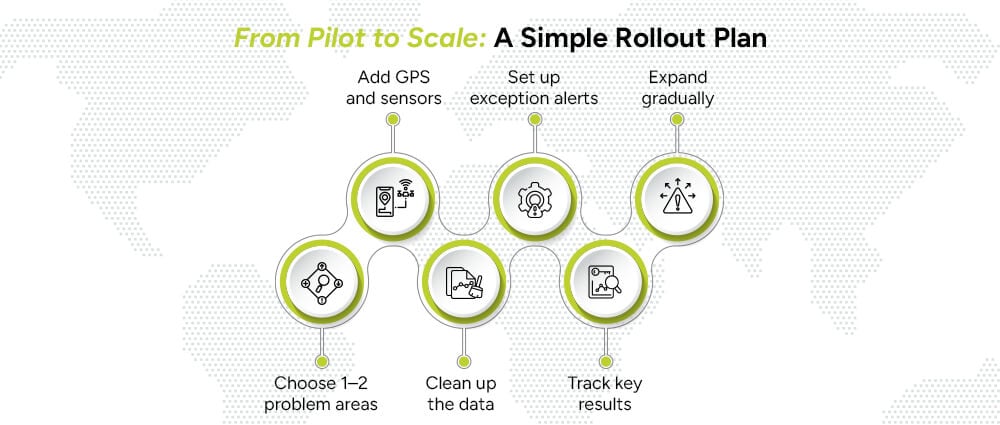
Focus on lanes or customers where delays, claims, or “where’s my order?” calls happen most. Decide how you’ll measure success (like improving on-time delivery or cutting detention fees).
Use vehicle trackers and portable devices to see where shipments are in real time. For sensitive goods, add sensors that check temperature or handling.
Make sure information from carriers and devices follows the same format. Clean, consistent data makes the system reliable.
Don’t just look at dashboards—set rules so issues go straight to the right person to fix. For example, someone should respond to a delay within minutes, not hours.
Keep an eye on numbers like on-time delivery, ETA accuracy, claims, and customer calls. Share results with carriers and celebrate improvements.
Once it’s working well, roll it out to more lanes, partners, and transport modes. You can even use pallet-level trackers for high-value or fragile goods.
Real-time visibility isn’t a shiny gadget; it’s a control system for your network. It turns uncertainty into manageable exceptions, transforms customer experience, and cuts the hidden costs of firefighting. With the IoT device wave growing and predictive analytics improving, the gap between scan-based tracking and real-time operations will only widen. Teams that move now will set a higher bar for reliability and keep it.
This is where Arpatech can help: by integrating advanced tracking tools, IoT-enabled devices, and predictive analytics into your logistics processes, we make it easier for you to gain true supply chain transparency, boost efficiency, and deliver the kind of customer experience that sets you apart.
Have a free consultation with our developers to rethink, reimagine, and revamp your logistics application development today.
It’s the continuous, live picture of your shipments: location (via GPS tracking), condition (via sensor technology like temperature, shock, tilt, humidity, and light), milestones (pickup, in-transit, out for delivery, delivered), exceptions (delays, route deviations, dwell, excursions), and a predictive ETA that updates as conditions change. Done right, it’s shared across your TMS, WMS, customer portals, and partner networks so everyone acts from the same real-time data.
By shrinking the “unknowns” that cause waste. You’ll lower detention/dwell with earlier notices and better dock scheduling; reduce spoilage and damage with live condition alerts; avoid failed first deliveries with last-mile tracking and proactive customer updates; and trim manual effort by replacing status-chasing with exception queues. These improvements stack up, especially in the last mile, where a large share of logistics costs sits.
Pick a small set of KPIs and track them weekly:
If those curves move the right way as your visibility coverage expands, you’re on the right track.
Ramsha Khan
Sep 23, 2025

Beyond the Last Mile: Optimizing Urban Delivery with AI...
Imagine this: it’s late afternoon, a customer anxiously tracking a parcel, a driver fighting traffic and searching for an apartment block with a confusing entrance, and a logistics manager watching fuel costs tick up as delivery windows slip. That drama, repeated across millions of daily shipments, is the reality of the “last mile.”
It’s the final stretch of a package’s journey and often the most expensive, unpredictable, and visible part of delivery. The good news? AI delivery and automation are rapidly turning this pain point into a playground for innovation, improving speed, cutting costs, and making urban logistics kinder to cities and customers alike.
In this guide, we’ll unpack practical ways to optimize last-mile delivery using AI and automation, explain why this matters for customer experience and sustainability
Two quick facts that show the scale of the problem: the last mile can account for roughly half of total shipping costs, making it the most cost-intensive part of deliveries.
Also, demand for last-mile delivery is expected to surge; some industry forecasts estimate major growth in parcel volumes by 2030, driven by rising e-commerce and urbanization.
What makes last-mile delivery so difficult in cities? A handful of predictable headaches: congestion, complicated building access, narrow streets, parking limits, unpredictable customer availability, and strict sustainability rules. All of these create variability, and variability is expensive.
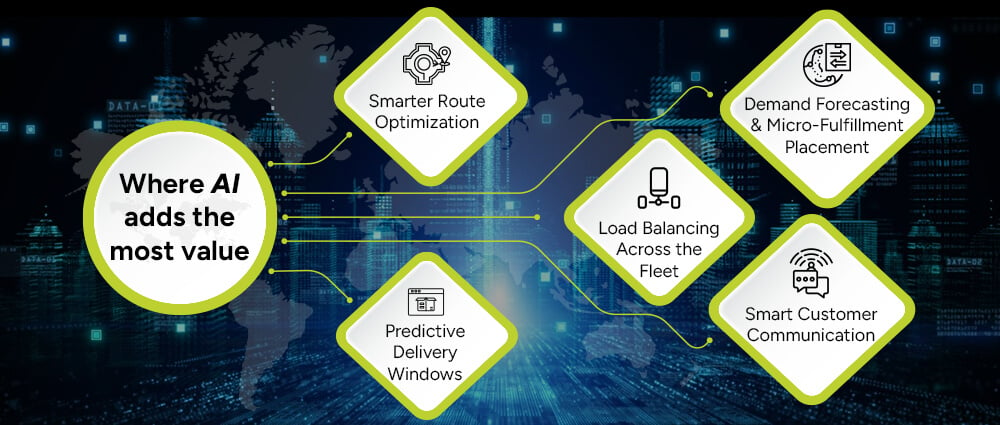
AI doesn’t replace delivery know-how; it amplifies it. Here are high-impact, realistic ways AI helps.
Traditional routing plans often assume static conditions. AI ingests live traffic, weather, historical delivery times, parcel volumes, and even micro-patterns (e.g., which streets are slow on market days) to produce dynamic routes that reduce idle time, cut miles driven, and maintain delivery windows.
Rather than saying “we’ll deliver today,” AI predicts a narrow time window by combining driver location, route sequencing, and stop-level historical performance. Narrow windows increase successful first-time deliveries and raise customer satisfaction.
Machine learning can decide, in real time, whether a drop should move to a nearby van, a bike courier, or a locker, based on capacity, urgency, and sustainability metrics.
Predictive models forecast order volumes at a hyper-local level. That lets companies stock micro-fulfillment centers and pop-up inventories near clusters of demand, slashing the miles needed for final delivery.
AI-driven messaging (SMS, app push, IVR) times alerts to when customers are most likely to respond, offers easy reschedule options, and collects delivery preferences, reducing failed delivery attempts.
When you combine these capabilities, route optimization becomes intelligent, customer experience improves, and operational costs fall.
Automation spreads across physical and digital layers.
There are currently trials of small autonomous shuttles that are self-driving mini-vans for fixed, predictable routes, for example, from a micro-fulfillment hub to a neighborhood hub, and possibly for some area local regulations, curb access, bus parking, AVs may be desirable.
Drones are also good for very short, lightweight, and low-traffic corridors, parks, waterfronts, or suburban edges, as accelerating single-item deliveries to surpass ground congestion, though rules and noise remain limiting factors in dense urban cores.
Including this category, practical automation-adjacent options in congested city centers are certainly the kind that grows agile and emits low emissions while transporting multiple packages from hubs to doorsteps.
That is transferring the last step from doorstep delivery to collection at a secure pickup point. Lockers decrease failure rates and improve efficiency by consolidating multiple deliveries into a single stop.
Internally, automation is speeding up sorting and packing to prepare parcels for optimized routes.
In practice, the best strategy is blended: a mix of human drivers, e-bikes, lockers, and automation tech, chosen based on density, parcel types, and local constraints.
If last-mile delivery optimization is a logistics issue, it is also an urban-planning one. Cities that create loading zones, approve micro-hubs, and put money into curb-management systems will make low-emission delivery more efficient. Partnering municipalities and logistics providers for curb-time windows, consolidated drop-off points, and shared micro-hubs would be a great way to reduce delivery traffic and emissions.
Sustainable delivery options, electrified vans, e-bikes, and planned consolidation points also help logistics businesses meet corporate sustainability goals while navigating urban restrictions and resident concerns about noise and pollution.
Delivery is now a core part of the product experience. A smooth last mile builds loyalty; a bad final mile drives customers away. Optimized deliveries reduce missed deliveries, faster ETA accuracy improves trust, and flexible options (time-slot booking, pickup points, easy returns) increase repeat purchases.
In short: improving last-mile delivery isn’t a cost center, it’s a revenue enabler.
If you’re a logistics manager or product owner, here’s a simple roadmap:
Small pilots let you learn fast with lower investment.
Optimizing routes and shifting to low-emission vehicles reduces fuel use and emissions, good for cities and for a company’s ESG profile. Consolidation and micro-hubs reduce the number of vans entering sensitive urban zones. In many cities, these operational improvements are becoming regulatory expectations, not just nice-to-haves.
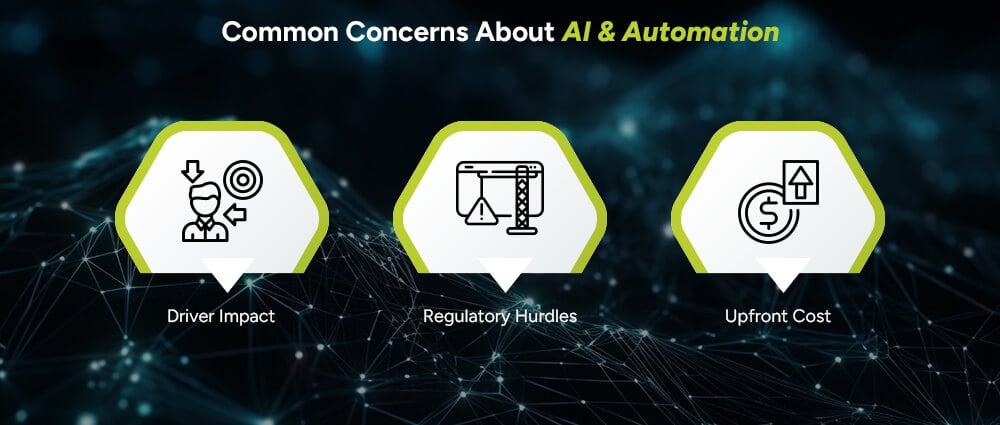
“Beyond the last mile” is more than a tagline; it’s a mindset. Logistics teams who see the last mile as a systems problem with inputs being urban planning + local fulfillment + intelligent routing + customer-centric communications give rise to accelerated deliveries with benefits of lower costs, happier customers, and greener cities. AI and automation provide great leverage in this transformation, but the real multipliers are practical experimentation: test small, measure honestly, and scale what genuinely reduces miles, time, and friction.
At Arpatech, we help businesses design and implement smart last-mile strategies by combining AI-driven route optimization, automation, and customer-focused delivery solutions, ensuring every shipment is not just efficient but also sustainable.
AI improves routing by analyzing large amounts of data (live traffic, historical stop times, delivery priorities, vehicle types, and driver behavior) to create dynamic, real-time route plans. Instead of static daily routes, AI can re-sequence stops on the fly, balance load across vehicles, and reduce empty miles, which leads to faster deliveries, lower fuel consumption, and fewer missed windows. (See earlier examples on dynamic re-routing and predictive ETAs.)
Track a mix of operational and experience KPIs:
Improvement across these measures after an AI/automation pilot indicates effective optimization.
Automation fits at multiple points: warehouse sorting and micro-fulfillment, on-street delivery aides (e-bikes, e-trikes), autonomous shuttles for fixed shuttles, drones for niche corridors, and parcel lockers for final pickup. The best results come from a mixed approach tailored to local density, parcel size, and regulatory environment.
Combine technology and design: provide accurate, narrow ETAs (AI-driven), allow customers easy rescheduling through simple links or apps, offer secure locker/pickup options, use driver apps that capture delivery notes and photos, and communicate proactively with customers about delays. Also, analyze failed delivery patterns and redesign routes or pickup options in high-failure zones.
Ramsha Khan
Sep 18, 2025

Open Banking: Learn about New Opportunities and Revenue...
Open banking is no longer just a regulation-driven project. With the right Open Banking Strategy, it has become a way for banks, fintechs, and businesses to create better services, cut costs, and open new revenue streams.
At its heart, open banking is about data sharing and API integration, letting customers safely connect their financial accounts with apps and services they trust. This shift is building collaborative ecosystems where financial services become more flexible, customer-friendly, and innovative.
Open banking allows customers to give permission for their financial data to be shared securely with other apps or platforms.
For example:
A budgeting app can pull in your bank transactions to give you a full money overview.
A shopping website can let you pay directly from your bank account, skipping the need for a card.
This happens through API integration, which acts as the secure “bridge” between different financial services. The rules for this come from regulatory frameworks such as PSD2 in Europe.
So in short, open banking = safe data sharing + clear customer control + modern financial services.
Open banking adoption is growing quickly:
The UK has already passed 15 million open banking users, with payments being the most popular use case.
Globally, the number of open banking API calls is expected to grow by over 400% by 2025, showing how fast businesses are building on these rails.
This growth proves customers are ready, and businesses are finding real value in payment innovation, lending, and financial insights.
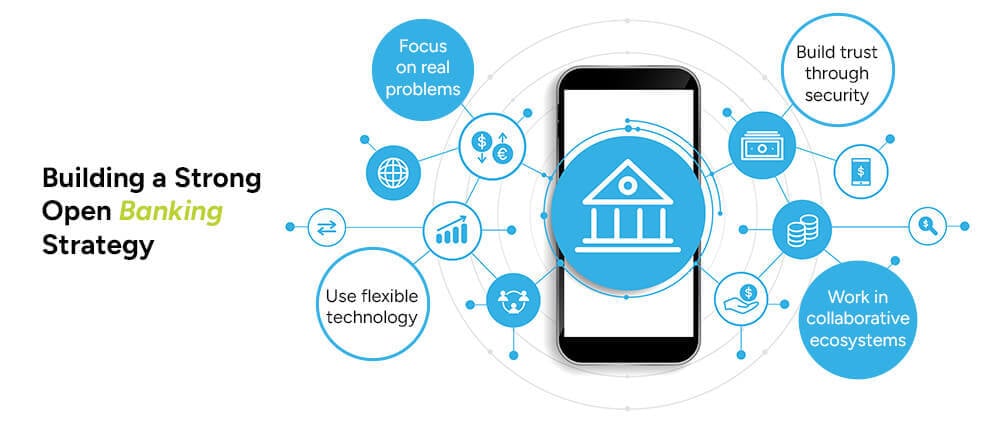
A good Open Banking Strategy starts with customer needs, not just technology. Here are the main steps:
Look at where customers struggle, slow onboarding, high payment fees, rejected loan applications, and design solutions that fix those pain points.
Data sharing must be secure. That means encryption, clear consent, and giving customers control over when and how their data is used.
With smart API integration, businesses can launch faster while staying safe. Keep systems modular so you can add or change partners without starting from scratch.
Work in collaborative ecosystems
Open banking works best when banks, fintechs, and merchants team up. These partnerships drive faster growth and better experiences for customers.
One of the fastest results from open banking is payment innovation. “Pay by bank” services allow customers to pay directly from their bank account instead of using a card.
This is why payment is often the first step in any Open Banking Strategy.
Open banking also transforms how financial services are delivered through data sharing:
Rather than wait days for micro-deposits to verify an account, one can merely log onto their bank, and it’s done instantly.
Lenders are able to assess cash flows in real-time to approve loans and include customers who are previously left out. This is a way of ensuring that there is financial inclusion.
Apps will know more about a personalized savings tips, personalized spending insights, or even personalized investment nudges that may be thrust upon the customer based on what they would have done as behavior.
This is where open banking moves beyond payments and creates new business models.
Businesses are using open banking to launch new business models that generate revenue and customer loyalty:
With consent, businesses can turn transaction data into insights, like income verification for loans or expense tracking for budgeting.
E-commerce platforms and apps can add loans, insurance, or savings features without becoming banks themselves.
Small businesses can pay for tools like automated reconciliation, instant payouts, or cash flow dashboards.
Companies that aggregate bank connections can charge developers or partners for access, support, and premium features.
Each of these models builds on safe API integration and clear regulatory frameworks.
There are two things an Open Banking Strategy must do: customer-centricity. Customers consent to data-sharing only if they:
Putting transparency and control in the hands of the user creates trust and enhances long-term loyalty.
Regulations may seem like a burden, but they create the foundation for trust. Regulatory frameworks ensure:
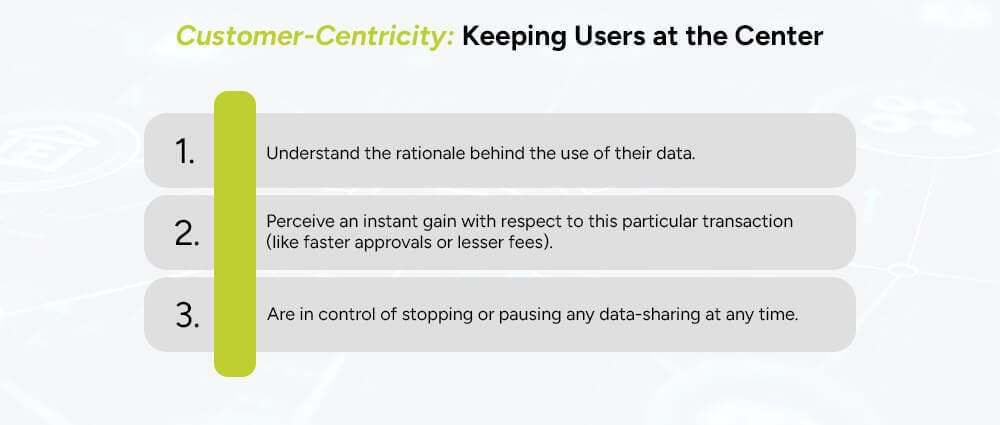
By treating compliance as part of product design, companies can move faster and stand out as trustworthy.
Open banking thrives on collaborative ecosystems. No single player can cover everything; banks, fintechs, merchants, and technology providers need each other.
Working together, they create financial services that are faster, cheaper, and more customer-friendly.
One of the most powerful benefits is financial inclusion. With real-time data sharing, people who don’t have long credit histories can still prove their reliability through income and spending records.
For example, a small business with steady cash flow but no collateral can get credit through open banking-powered assessments. This helps underserved groups participate more fully in the financial system.
Many businesses ask: how do we earn money from open banking? The answer often lies in data monetization.
With consent, transaction data can be enriched and sold as insights, for example, risk scoring, spending categorization, or loan decision signals. The key is to ensure that customers also see value, so the exchange feels fair.
This creates a win-win: businesses generate income, while customers get faster, more relevant services.
Open banking is no longer only about compliance; it’s about opportunity. With the right Open Banking Strategy, secure API integration, and customer-first design, businesses can now adapt new business models, expand financial inclusion, and create real value through payment innovation and data monetization.
By building strong collaborative ecosystems and working within clear regulatory frameworks, financial services can evolve into something smarter, faster, and more human. This is where Arpatech can help by guiding you through strategy, building secure integrations, and creating scalable digital solutions that turn open banking into real business growth.
Through encryption, tokenization, and secure API integration. Customers should always be in control of what data is shared and for how long. Strong regulatory frameworks also provide protection.
The biggest challenge is aligning incentives. Banks pay for the infrastructure, but fintechs and merchants often see the most benefits. Clear partnerships and shared revenue models in collaborative ecosystems help solve this.
Ramsha Khan
Sep 16, 2025

The Digital Fortress: Building Security in Fintech Solu...
If money makes the world go round, Fintech Security keeps the wheels from flying off. Whether you’re building a payments app, a robo-advisor, or a lending platform, customers hand you their most sensitive data and expect secure transactions by default. The challenge is that attackers adapt quickly, regulations keep evolving, and users won’t tolerate clunky experiences.
That’s why Fintech Security isn’t just a “tech feature”, it’s the foundation of trust between companies and their users.
This is your guide to building what we’ll call a digital fortress: a system that protects users from threats, complies with regulations, and makes people feel confident every time they use your app.
Let’s face it, fintech companies are prime targets for hackers. Why? Because money and personal data are directly involved. A single weak spot can result in stolen identities, drained accounts, or major fraud, ultimately eroding trust overnight.
The impact of a breach isn’t just technical; it’s financial and reputational. According to IBM, the average cost of a data breach in 2025 was around $4.4 million, and that doesn’t even count the loss of customer trust.
On top of that, Verizon’s 2025 report shows that 88% of web application attacks happen because of stolen logins. That means the weakest link is often just a password!
These numbers tell us one thing: cybersecurity in fintech is not optional; it’s survival.
To build strong data protection systems, fintechs need to think like attackers. That means:
This “fortress mindset” keeps you one step ahead.
Financial data is as precious as gold. Here’s how fintech should protect it:
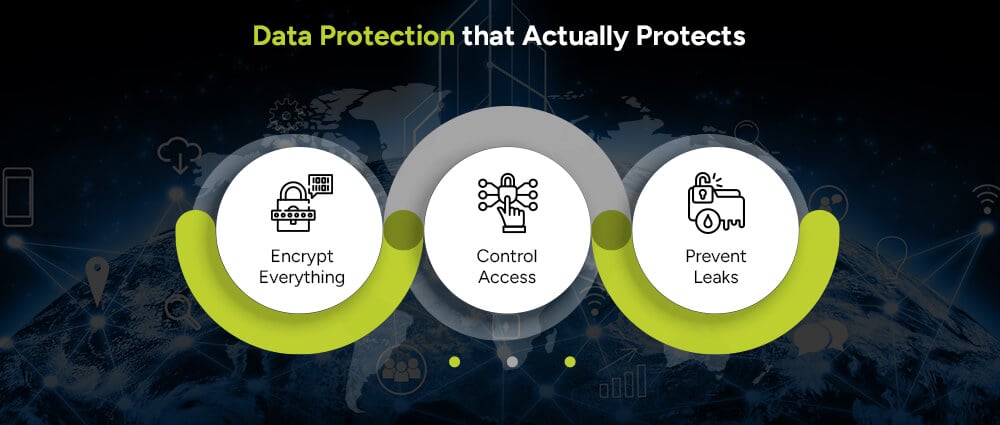
Use strong encryption so data is scrambled when stored and while moving across networks. Even if hackers grab it, it will look like nonsense.
Not every employee needs to see everything. Limit who can view sensitive information, and record every access attempt.
Don’t let private details slip into logs, analytics, or third-party apps. Set rules to stop sensitive information from “leaking out” unnoticed.
By making encryption and strict data privacy policies part of your foundation, you’re already raising the walls of your fortress.
Let’s be honest, passwords are weak. People reuse them, write them down, or choose easy ones. That’s why fintechs are moving towards stronger login methods:
This way, you keep logins smooth but also add smart layers of fraud prevention.
Fraud is one of the biggest threats to fintech platforms. However, here’s the catch; there are too many security checks can frustrate users. The solution? Balance.
If done right, fraud prevention happens in the background and only surfaces when necessary, keeping secure transactions smooth and user-friendly.
Fintech apps rely on many third-party tools, cloud services, and code libraries. That’s why hackers often try to attack the “supply chain” instead of the app directly. To protect against this:
Think of it like checking every brick before building a wall, because one bad brick could collapse the whole thing.
There’s a lot of hype around blockchain security in fintech. While it’s not a magic fix, it can help in important ways:
But blockchain comes with its own challenges. Smart contracts must be coded perfectly because even a minor bug could be disastrous, and securing digital wallets is critical.
Even the best systems can face issues. The key is catching problems early:
The faster you respond, the less damage attackers can do.
Fintechs operate in one of the most regulated industries. Following regulatory compliance isn’t just about avoiding fines; it’s about protecting customers.
The best way to stay compliant is to adopt frameworks:
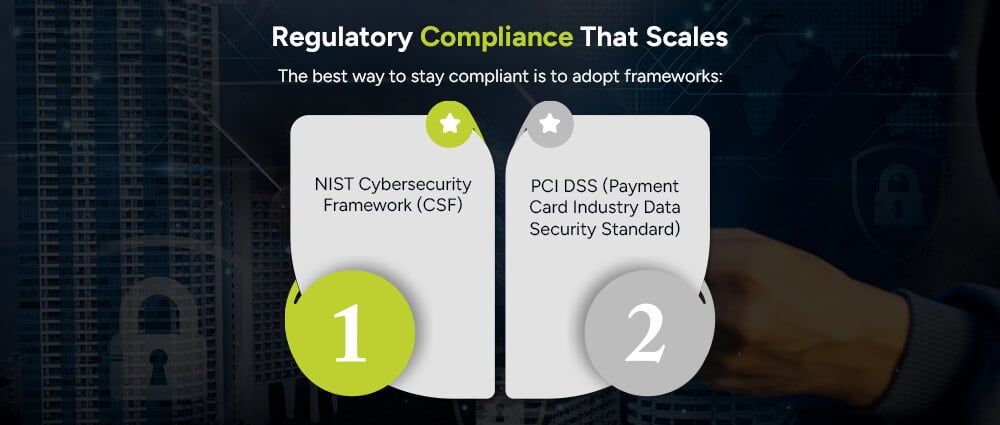
By building controls around these frameworks, you’ll stay prepared as laws and rules keep changing.
Security and data privacy go hand in hand. Here are a few golden rules:
This makes your system safer and shows customers you respect their privacy.
No matter how advanced your technology gets, people can be the weakest link. A careless click or a stolen laptop can open the gates. That’s why:
Strong human habits add another layer to your digital fortress.
Here’s a simple list every fintech should follow:
Think of these as the walls, gates, and guards of your digital fortress.
Fintech security is by no means an easy matter but it is ultimately a matter of trust. Users expect their money and personal information to be secure but at the same time they do not want to be inconvenienced by prolonged security checks. Fintechs can offer the best of both worlds through the mix of cybersecurity, intelligent fraud prevention, biometric authentication and adherence to worldwide standards.
And remember: a fortress is never “finished.” Security requires constant updates, monitoring, and improvements as threats evolve. This is where Arpatech can help. With our expertise in fintech security solutions, risk management, and regulatory compliance, we build scalable, future-ready systems that not only protect sensitive data but also enhance the user experience. From implementing strong encryption to designing adaptive fraud detection and secure cloud architectures, Arpatech partners with you to turn security into a true business advantage.
At minimum: encryption, strong authentication (biometrics or FIDO2), least-privilege access for employees, fraud detection tools, secure APIs, monitoring for unusual activity, and compliance with frameworks like PCI DSS.
Use adaptive security. For normal, low-risk actions, keep the experience fast. For risky ones (like large transfers), step up with biometrics or extra checks. This way, most users stay happy while fraudsters are stopped.
NIST Cybersecurity Framework (CSF) for overall risk management, and PCI DSS if you handle card payments. These give fintechs a structured way to prove they’re secure and compliant.
Yes. The blockchain changes the game for the records by making them tamper-proof, increasing transparency, and granting the possibility of smart contracts for secure transactions. Nonetheless, the technology demands robust coding, wallet security, and proper handling. Consequently, it’s a beneficial instrument, but not a cure-all.
Ramsha Khan
Sep 11, 2025

How Blockchain Smart Contracts Are Revolutionizing Insu...
If you’ve ever filed an insurance claim, you know the drill: forms, back-and-forth emails, waiting for verification, then waiting some more for payment. In 2025, that experience is getting a serious upgrade. The catalyst? blockchain smart contracts insurance solutions that bring automated claims processing, trust, and transparency to every step.
Think of a smart contract as a tiny program that lives on a blockchain. It holds the rules of your policy (what’s covered, how much, under what conditions) and it can automatically run those rules when certain events happen. Instead of humans pushing paper, software enforces the policy. The result is blockchain claims automation that shortens timelines, reduces disputes, and helps carriers scale efficiently.
Let’s unpack how it actually works, and where it’s already making a difference.
Modern insurers have invested heavily in digital claims management, but there are still friction points:
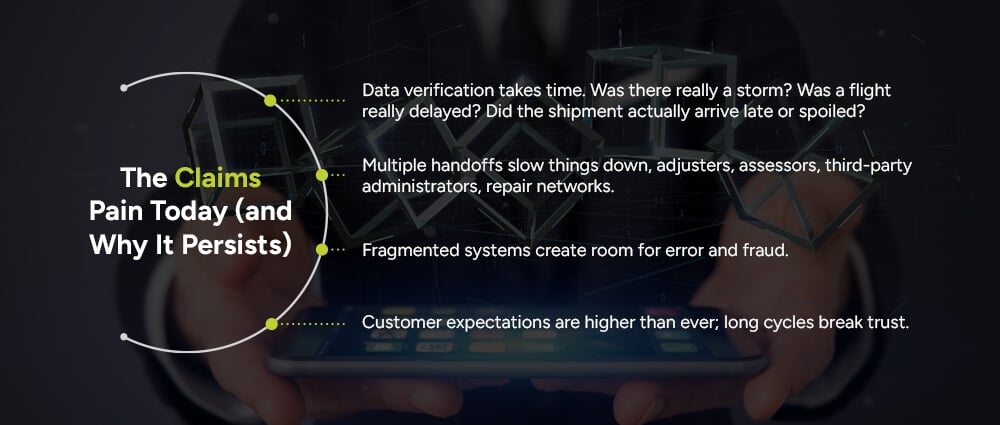
To calibrate the challenge, consider one current benchmark: J.D. Power reported that U.S. auto repair cycle times during 2024 averaged 18.9 days later in the fielding period, down from 23.9 days earlier, but still weeks of waiting for many customers.
That context matters: any insurance technology innovation that can shave off verification time, automate payouts, and remove redundant steps is a big win.
A smart contract is basically the policy logic turned into code and deployed on a blockchain. Here’s how that changes the game for digital insurance transformation:
The rules you see in your policy PDF, deductibles, coverage limits, and exclusions, become program logic. If X happens and the evidence meets condition Y, the contract triggers outcome Z. This is insurance process optimization at its core.
Smart contracts don’t guess. They wait for cryptographic proof or reliable data from oracles (secure data bridges) to confirm an event. This is the backbone of blockchain claims verification.
Once the trigger is verified, the contract can initiate automated insurance settlements: releasing a payment, notifying a bank, sending instructions to a repair partner, or updating the claim’s status. Human intervention is reserved for exceptions.
Every decision step is recorded, so disputes drop and compliance is easier. Auditors can confirm what happened, when, and why.
The upshot: true blockchain insurance efficiency. Less back-and-forth, fewer manual checks, faster decisions, and consistent outcomes.
Smart contracts shine brightest in smart contract use cases insurance, where the loss event is objective and data-driven. That’s why parametric products, policies that pay when a measurable trigger occurs, have become the poster child for blockchain claims automation.
These are high-fit use cases because the truth lives in data, exactly what smart contracts consume.
Here’s the typical flow for smart contract implementation insurance claims:
A data oracle supplies secure, tamper-resistant feeds: weather indices, IoT telemetry, flight times, shipping milestones, mortality records, or verified documents. The contract watches for thresholds.
The smart contract compares incoming data with the policy logic: “Was rainfall under 10 mm for 15 consecutive days?” “Was the shipment temperature above 8°C for more than 30 minutes?” This is the blockchain smart contracts insurance brain at work.
If conditions are met, the contract executes: initiates payment, notifies stakeholders, closes the claim, or triggers a further check. With automated claims processing, settlement can be near-real time for straightforward cases.
Real-world case studies continue to emphasize the role of secure oracles to feed smart contracts with tamper-resistant data, particularly in parametric models where automation is the product.
The benefit to policyholders is simple: speed and certainty. For customers, smart contract insurance benefits show up as:
For insurers, insurance process optimization means lower handling costs and a better experience, all while freeing adjusters to focus on complex claims.
One forward-looking benchmark: McKinsey has estimated that by 2030, more than half of current claims activities could be replaced by automation, a signpost for the industry’s direction and a strong rationale for investing in claims automation now.
You’ll see the earliest and cleanest wins in lines of business with objective data triggers:
As confidence grows, carriers are layering smart-contract elements into traditional indemnity claims too, using blockchain to verify documents, log adjuster decisions, orchestrate vendor steps, and automate partial payments while repairs are underway. That’s hybrid digital claims management in action.
A practical smart contract implementation insurance blueprint usually looks like this:
Critically, none of this requires your entire stack to “move to blockchain.” Most insurers are adding a smart-contract layer that plugs into existing core systems via APIs, an incremental path to digital insurance transformation.
Smart contracts are code, so treat them like critical software:
Done right, GRC becomes a blockchain insurance efficiency driver, not a blocker.
Even with clear benefits, executives want numbers. Here’s how teams justify investment:
Remember our baseline: multi-week auto claim cycles are common today, and projections show large portions of claims activity trending toward automation by 2030. Those two facts alone make a compelling case to pilot blockchain claims automation now.
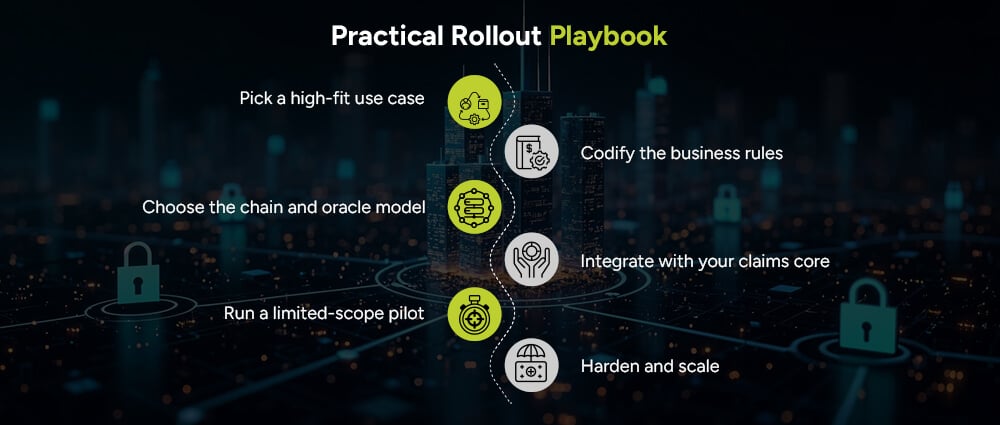
To make smart contract implementation insurance succeed, keep the rollout focused and iterative:
Parametric travel delay, a weather-indexed cover, or a narrow slice of cargo claims. Keep the trigger objective and the data source strong.
Translate policy text into precise “if/then” logic: thresholds, time windows, locations, deductibles, limits, exclusions.
Permissioned vs. public with privacy layers; single or multiple data oracles; fallback logic for missing data.
Start with read/write APIs to your FNOL intake, document vault, payment processor, and vendor system. Orchestrate events with a lightweight middleware.
Run a limited-scope pilot
Real customers, real payouts, limited geography. Measure speed, cost-to-serve, dispute rate, and customer satisfaction.
Add more data feeds, expand geographies and perils, and introduce hybrid models that automate portions of indemnity claims (document checks, payments triggers at milestones).
By following this path, you’ll turn “innovation theater” into measurable insurance process optimization.
In 2025, smart contracts are moving from concept to core capability. When you strip away the buzzwords, you’re left with something both simple and powerful: policy rules that enforce themselves when trusted data says it’s time. That’s the essence of blockchain smart contracts insurance, and it’s why customers, and carriers, are feeling the difference.
Use cases that leverage objective, third-party data are already delivering results, while more complex claims are gaining automated checkpoints that reduce friction and speed settlements. With only a modest lift to integrate, insurers can unlock faster, fairer, and more transparent claims, exactly what policyholders have wanted all along.
At Arpatech, we help insurers and enterprises bring these innovations to life. From building secure smart contract frameworks to integrating blockchain with your existing claims systems, our team ensures a smooth transition toward digital insurance transformation. Whether you’re piloting parametric covers or modernizing traditional claims workflows, the consultants at Arpatech provide the expertise, technology, and support to make automated claims processing a practical reality for your business.
They automate the busywork. Instead of people collecting and checking evidence step by step, the contract listens for trusted event data (like verified flight delays, weather indices, or IoT sensor readings). When conditions match the policy rules, it triggers actions automatically, like approving the claim or initiating payment. This removes handoffs and compresses cycle time, a major goal of digital claims management and insurance technology innovation.
Common triggers in smart contract use cases insurance include:
Start where proof is objective and coverage is binary: parametric travel, weather-indexed agri, and cargo/IoT-based policies. From there, layer automation into parts of traditional claims: document checks, milestone-based partial payouts, and vendor orchestration. This staged approach delivers early value while you build toward broader blockchain insurance efficiency.
Ramsha Khan
Sep 9, 2025

Blockchain-Based Parametric Insurance: Instant Payouts ...
When natural disasters strike, time is everything. Whether it’s a hurricane ripping through coastal towns, a flood destroying farmland, or an earthquake shaking a city to its core, people and businesses need financial help… and fast. Traditional insurance processes, however, are often slow, involving paperwork, manual assessments, and back-and-forth communication. That delay can make recovery even harder.
But imagine this: instead of waiting weeks or months for an insurance payout, policyholders could get their money automatically, sometimes within hours of a disaster being confirmed. No lengthy claims process. No delays. Just instant insurance payouts when they’re needed most.
That’s exactly the promise of blockchain-based parametric insurance, a new model that’s changing the future of disaster relief and risk management.
Before diving into how blockchain transforms it, let’s first understand parametric insurance.
Traditional insurance works like this: you file a claim after damage occurs, adjusters inspect the loss, and then your insurer decides how much you’re owed. It’s reactive, time-consuming, and often disputed.
Parametric insurance, on the other hand, doesn’t wait for all that. Instead, it pays out automatically when a predefined event happens. For example:
The payout isn’t based on actual loss verification but on triggers, measurable parameters like weather data, seismic readings, or rainfall indexes. That’s why it’s called parametric insurance.
It’s fast, transparent, and removes much of the back-and-forth that is slowing down traditional insurance right now.
Now, here’s where things get exciting.
Adding blockchain technology to parametric insurance makes it even more powerful. Using smart contracts, insurance payouts can be fully automated. A smart contract is like a self-executing digital agreement that triggers once conditions are met.
So, if satellite weather data confirms a flood in a certain region, the smart contract parametric insurance program on the blockchain instantly releases funds to all affected policyholders. No human approval required.
You get no delays, no waiting for manual approvals. Payouts happen automatically, whenever something goes wrong.
All conditions and transactions are visible on the blockchain, leaving no room for disputes from policyholders or insurance companies.
Policyholders get to have blind trust as they don’t have to “trust” the insurer’s word; the contract executes as coded.
Eliminates paperwork and reduces administrative costs, streamlining the work and bringing reliability to the operations during a dire time.
That’s why parametric insurance blockchain technology is being hailed as one of the most important innovations in digital insurance solutions.
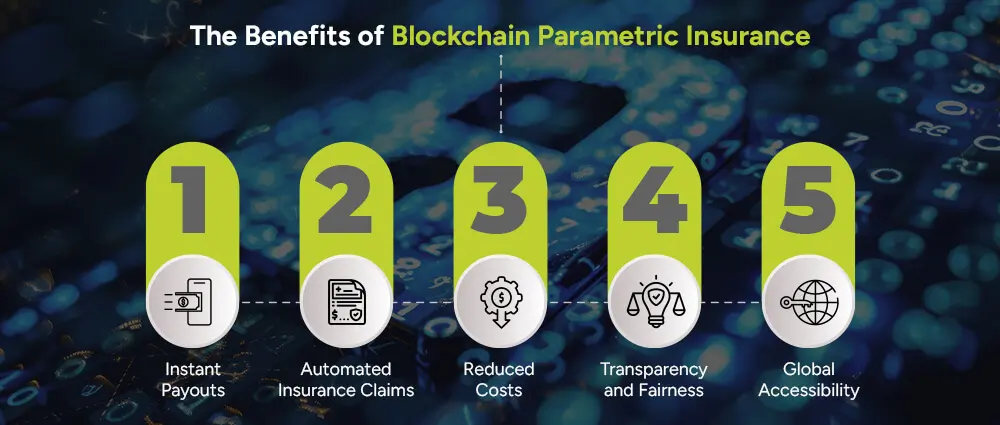
Let’s break down the key benefits in a simple way:
The biggest assurance is an instantaneous insurance settlement. This can definitely change lives of those suffering beyond their control. Farmers are fed with the seeds for the next season, families get home far from disaster zones, and businesses catch up on their operations without being paralyzed due to delays.
Automated insurance claims would eliminate further actions like filing, waiting for adjusters, and settlements. This alleviates the process, rendering it fast and non-stressful.
Fewer intermediaries and administrative costs mean that insurers can lower costs and pass these financial blessings onto the most deserving in terms of policyholders.
Due to the blockchain, the nature of the finances, including the exact data triggers, becomes very clear indeed, utterly decimating disputes. Each one knows right from the start.
With parametric insurance platforms powered by blockchain, insurance can reach underserved regions. Farmers in developing countries, for example, could benefit from blockchain crop insurance that protects them against droughts or floods.
This isn’t just theory, it’s already happening.
Weather events cause billions in damages every year. With blockchain weather insurance, payouts are tied to objective weather data, such as rainfall or wind speed. If the data confirms the trigger, money flows instantly to those affected.
Farmers are among the biggest beneficiaries. Blockchain crop insurance allows them to protect their livelihoods against unpredictable weather. Imagine a farmer in Africa automatically receiving funds after a season of low rainfall, without ever filing a claim. That’s transformative.
For earthquakes, floods, or hurricanes, blockchain ensures automated disaster claims are processed instantly. This helps governments, businesses, and individuals bounce back faster after a disaster.
Businesses in logistics, tourism, energy, and media sectors are also using blockchain parametric insurance benefits. A shipping company, for example, could insure against port closures caused by storms and receive an instant payout when thresholds are breached.
The beauty of blockchain insurance innovation lies in how it enhances trust and automation.
In traditional insurance, trust depends on intermediaries. You trust the insurer, the adjuster, and even the reinsurance company. In blockchain parametric insurance, trust is transferred to code and data.
Smart contracts automatically verify whether the event occurred using trusted data sources like satellites, sensors, or meteorological agencies. Once verified, the payout is triggered instantly.
This eliminates the risk of fraud, mismanagement, or delay.
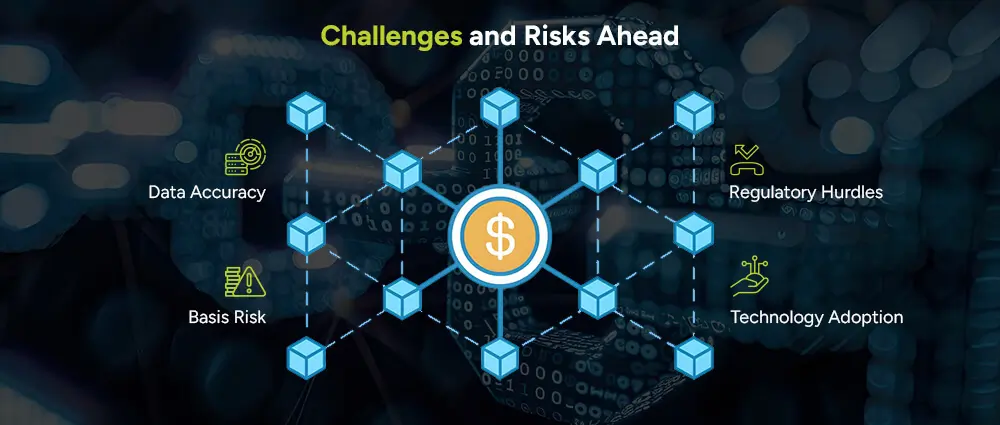
Of course, no system is perfect. For all its promise, parametric insurance blockchain technology still faces some challenges:
The system depends on reliable data sources. If data is faulty or manipulated, payouts could be unfair. So, data integration with blockchain is quite useful.
Sometimes, policyholders may suffer losses even though the parametric trigger wasn’t met (for example, a farmer whose field is flooded but rainfall didn’t cross the set threshold). This mismatch is called basis risk.
Insurance is heavily regulated, and blockchain-based solutions may face compliance challenges across different countries.
While the idea is strong, widespread adoption requires education, infrastructure, and trust in digital systems.
Despite these challenges, the momentum is undeniable. Many insurers, startups, and global institutions are already testing and rolling out parametric insurance platforms using blockchain.
We’re standing at the edge of a revolution in the insurance industry. Natural disasters are increasing in frequency and severity due to climate change, making fast financial recovery more important than ever.
Blockchain parametric insurance is not just a new product, it’s a shift in how insurance is designed, delivered, and trusted. It’s an example of how digital insurance solutions can close the gap between disaster and recovery.
From protecting farmers’ crops to helping small businesses survive storms, from covering entire communities to ensuring governments can respond quickly, this model has the potential to reshape global disaster response.
See how Arpatech can shape the emergency landscape and help in fast and efficient disaster recovery. Get insurance plans that are automated and software that don’t require attention, automate your recovery to get back on your feet as fast as possible.
Blockchain ensures automation, transparency, and trust. With smart contracts, payouts are executed instantly once conditions are met. This removes human delays, reduces fraud, and builds confidence in the system.
Carriers should watch for basis risk (when losses don’t perfectly match triggers), data reliability (ensuring sensors and weather stations are accurate), and regulatory compliance across different markets.
The strongest early use cases are in weather-based risks such as drought, flood, and hurricanes. That’s why blockchain weather insurance and blockchain crop insurance are already being tested widely. These areas have clear, measurable parameters and deliver high value to communities most vulnerable to disasters.
Ramsha Khan
Sep 4, 2025

Mobile DevOps App Integration: Key to Faster, Smarter...
Mobile apps today aren’t just for advanced organizations; they’re the lifeblood of customer engagement, business growth, and brand loyalty. So, from stuff like ordering food to getting rides, mobile banking, and keeping track of our health, apps have changed the way we live, work, and connect with others. But behind all the ease with which these apps work lies a world of complex code, infrastructure, and operations. That’s where mobile devops app integrations come into play.
Traditionally, app development and infrastructure management were completely distinct: a developer developed an app, but IT teams managed servers and deployments. But gaps have created bottlenecks, as mobile apps became more complex and user expectations began to rise. Mobile DevOps is now at work to close that gap, bringing development to infrastructure and operations in order to deliver faster, smoother, and more reliable apps.
Next, we are going to discover what exactly Mobile DevOps is, the way it contributes to the process of iOS and Android application development, what problems it clears, and how to put actions on it in your business. Let’s go deeper.
Before we go further, let’s answer the core question: What is Mobile DevOps in iOS and Android App Development?
In simple terms, Mobile DevOps is the practice of applying DevOps principles, automation, collaboration, and continuous delivery to mobile apps. It ensures that mobile app development and operations teams work together seamlessly across the app lifecycle.
Where traditional development might rely on isolated processes, Mobile DevOps best practices emphasize:
This approach isn’t just about tools; it’s a cultural shift. It makes developers, QA testers, operations engineers, and even business stakeholders part of the same journey.
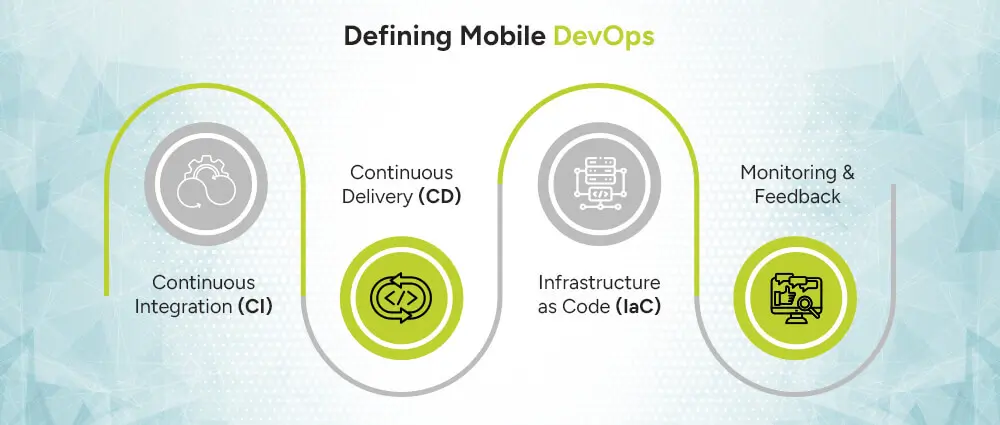
You may be wondering, can’t we just apply the same DevOps trends that we use for web or desktop apps? Not quite. Mobile apps come with their own unique set of challenges:
Development is frequently done in tandem for iOS and Android, across various programming languages, SDKs, and deployment scenarios.
Mobile apps must be put through the App Store or Google Play Store review process, resulting in mandatory delays, unlike web apps that always deploy on demand.
Most notable on Android, this [diversity or plurality] becomes even more overwhelming with different screen sizes, OS versions, and thousands of hardware configurations that a developer has to accommodate.
Most mobile applications are expected to be functional in an offline condition or under a low connectivity environment, increasing the complexity of testing scenarios.
People expect their mobile application to load within 2 seconds and never crash. In fact, a Statista report states that 25% of applications are abandoned after the first use, which is intimidating.
These differences highlight why traditional DevOps doesn’t fully fit mobile development, which brings us to the next point.
Traditional DevOps, designed with server-side and web applications in mind, often struggles in mobile contexts because:
This is why mobile DevOps app integration needs specialized workflows, business intelligence tools, and strategies.
So what’s the actual role of DevOps in mobile app development? At its core, DevOps ensures that developers can build and deliver apps quickly while operations teams ensure those apps run smoothly on real devices. Together, this means:
Think of it this way: developers build the car, operations maintains the roads, and DevOps is the bridge ensuring the car reaches its destination without bumps.
If you’re working with a DevOps and mobile app development company, here’s what you stand to gain:
To put this in perspective, Puppet’s 2023 State of DevOps report found that high-performing DevOps teams deploy software 208 times more frequently than low-performing teams. For mobile apps, that’s the difference between being the market leader or playing catch-up.
You can’t talk about Mobile DevOps without mentioning tools. Some popular DevOps tools for mobile app development include:
The right combination depends on your app’s size, team expertise, and budget.
Here’s a simplified roadmap for adopting DevOps in your mobile app projects:
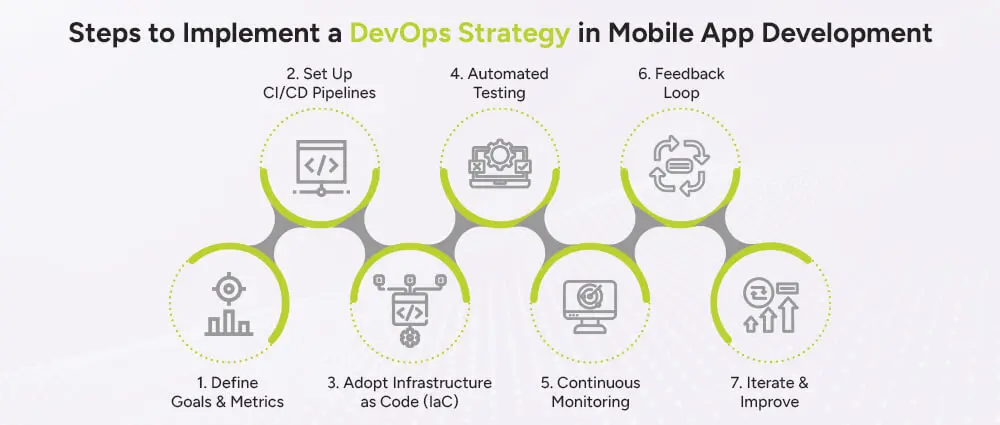
Establish the goal – be it speed versus stability or user experience – and measure the performance through KPIs such as build success rate or crash-free sessions.
Automate the entire build-test-deploy cycle to enable quicker and far more reliable releases, using tools such as Jenkins, Bitrise, or GitHub Actions.
Scripting of the Infrastructure using Terraform or AWS CloudFormation in order to ensure backend environments that are consistent and scalable.
Add unit, integration, UI, and device tests with products like Firebase Test Lab to ensure app stability at the device level.
Catching crashes, performance, and user failing with tools like Crashlytics or New Relic keeping an eye on the issue before the users do.
Promote collaboration between developers, quality assurance, operations, and DevSecOps teams by using shared dashboards and automated alerts.
Our pipelines, tests, and monitor systems will be continuously optimized to meet the higher and very much new demands from devices, OS updates, and user expectations.
This roadmap outlines how to get started with Mobile App DevOps in practical steps.
In a company engaged in DevOps and mobile app development, responsibilities are usually shared, although they may include:
Thus, this collaborative model ensures that no team works in isolation.
For newbies, here are some pointers:
Mobile DevOps app integration isn’t just a luxury for advanced apps anymore; it’s a necessity in today’s app-driven world. Traditional DevOps models weren’t built for the unique challenges of mobile, but Mobile DevOps bridges the gap between app development and infrastructure management. By adopting the right culture, tools, and processes, businesses can achieve faster releases, better quality, and happier users.
Outsource your DevOps to the right people, and work with the ideal DevOps Services and team if you’re serious about scaling your mobile app, the question isn’t if you should adopt DevOps, it’s when. Let the team at Arpatech help you develop your next mobile app.
Yes, DevOps principles help in faster delivery, app stability, and user satisfaction, whether you are building a simple utility app, a gaming app, or an enterprise-grade solution. The core benefit exists regardless of the scale and complexity of the implementation.
The cost of implementing DevOps for mobile apps may vary greatly due to the largely differing influences such as the size and complexity of the application, tools and infrastructure you prefer, and whether you go with an in-house team or a consulting partner. Simple projects incur lesser costs and simpler setups, while larger enterprises with complex needs probably pour more money into robust pipelines, advanced automation, and maintenance. In the end, it all comes down to your goal-setting, scalability ambition, and long-term plan.
Look for a mobile app DevOps partner who:
Ramsha Khan
Aug 28, 2025